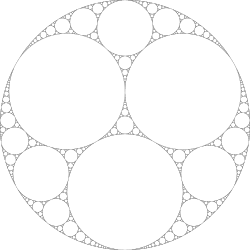Integral Apollonian gaskets| Beginning curvatures | Symmetry |
|---|
| −1, 2, 2, 3, 3 | D2 | | −2, 3, 6, 7, 7 | D1 | | −3, 4, 12, 13, 13 | D1 | | −3, 5, 8, 8, 12 | D1 | | −4, 5, 20, 21, 21 | D1 | | −4, 8, 9, 9, 17 | D1 | | −5, 6, 30, 31, 31 | D1 | | −5, 7, 18, 18, 22 | D1 | | −6, 7, 42, 43, 43 | D1 | | −6, 10, 15, 19, 19 | D1 | | −6, 11, 14, 15, 23 | C1 | | −7, 8, 56, 57, 57 | D1 | | −7, 9, 32, 32, 36 | D1 | | −7, 12, 17, 20, 24 | C1 | | −8, 9, 72, 73, 73 | D1 | | −8, 12, 25, 25, 33 | D1 | | −8, 13, 21, 24, 28 | C1 | | −9, 10, 90, 91, 91 | D1 | | −9, 11, 50, 50, 54 | D1 | | −9, 14, 26, 27, 35 | C1 | | −9, 18, 19, 22, 34 | C1 | | −10, 11, 110, 111, 111 | D1 | | −10, 14, 35, 39, 39 | D1 | | −10, 18, 23, 27, 35 | C1 | | −11, 12, 132, 133, 133 | D1 | | −11, 13, 72, 72, 76 | D1 | | −11, 16, 36, 37, 45 | C1 | | −11, 21, 24, 28, 40 | C1 | | −12, 13, 156, 157, 157 | D1 | | −12, 16, 49, 49, 57 | D1 | | −12, 17, 41, 44, 48 | C1 | | −12, 21, 28, 37, 37 | D1 | | −12, 21, 29, 32, 44 | C1 | | −12, 25, 25, 28, 48 | D1 | | −13, 14, 182, 183, 183 | D1 | | −13, 15, 98, 98, 102 | D1 | | −13, 18, 47, 50, 54 | C1 | | −13, 23, 30, 38, 42 | C1 | | −14, 15, 210, 211, 211 | D1 | | −14, 18, 63, 67, 67 | D1 | | −14, 19, 54, 55, 63 | C1 | | −14, 22, 39, 43, 51 | C1 | | −14, 27, 31, 34, 54 | C1 | | −15, 16, 240, 241, 241 | D1 | | −15, 17, 128, 128, 132 | D1 | | −15, 24, 40, 49, 49 | D1 | | −15, 24, 41, 44, 56 | C1 | | −15, 28, 33, 40, 52 | C1 | | −15, 32, 32, 33, 65 | D1 |
|








































